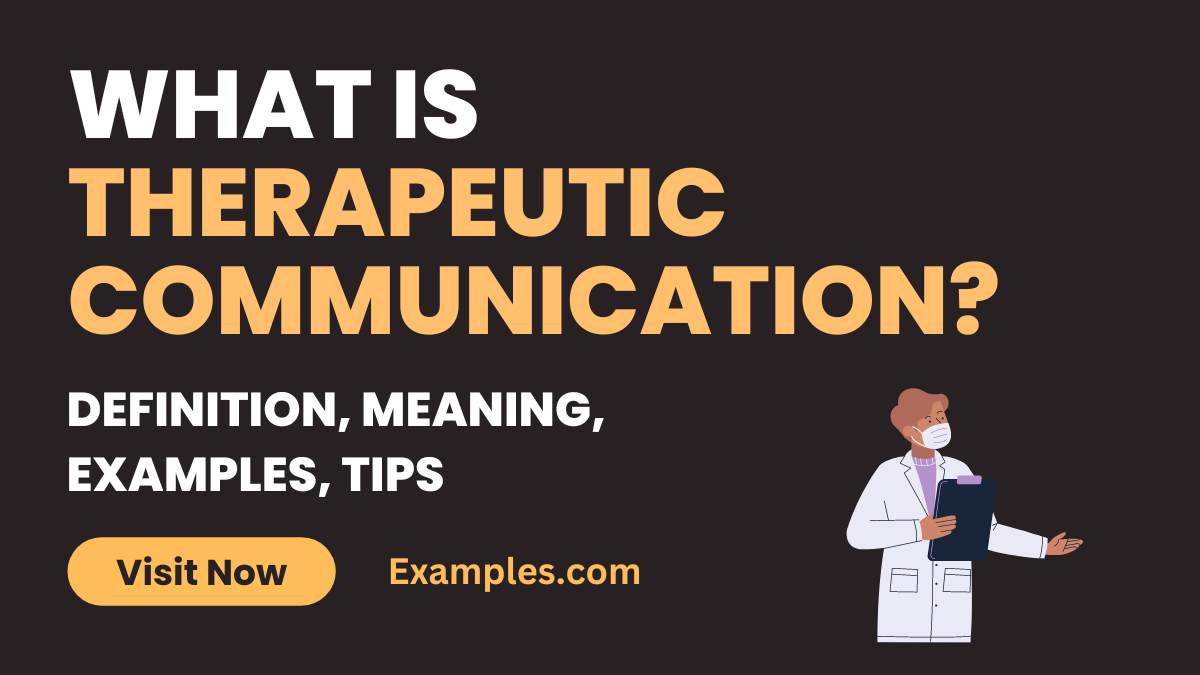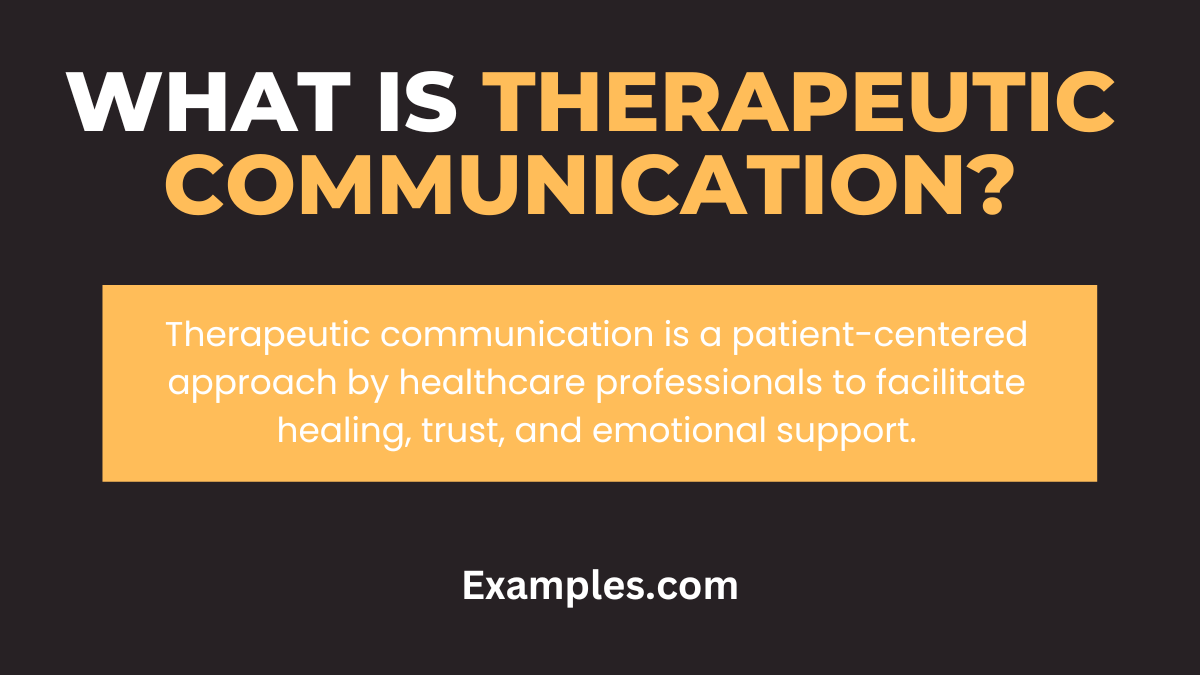What is Therapeutic Communication?
Embark on a journey to master Therapeutic Communication with our comprehensive guide, rich in practical examples and valuable insights. This guide is tailored to unravel the intricate layers of Therapeutic Communication, offering an in-depth understanding of its definition, significance, and application. Whether you’re a healthcare professional, counselor, or someone looking to enhance personal communication skills, this resource is your essential companion. It not only explains the core principles but also provides actionable tips and real-life scenarios, showcasing how to effectively use Therapeutic Communication in various contexts to foster understanding, empathy, and healing.
What is Therapeutic Communication? – Definition
Therapeutic Communication is a specialized form of interaction, primarily used in healthcare settings, that is focused on advancing the physical and emotional well-being of a patient. This type of communication involves employing specific strategies and skills to encourage a more profound understanding and connection between the healthcare provider and the patient. The goal is to create a safe and supportive environment where patients feel comfortable to express their feelings, fears, and concerns, allowing for more effective treatment and care.
Examples of Therapeutic Communication
- Reflecting: A nurse might say to a patient, “It sounds like you’re really worried about this surgery,” reflecting the patient’s feelings to show understanding and empathy.
- Clarifying: A therapist could ask, “When you say you feel overwhelmed, what specific situations are you referring to?” This helps to gain a clearer understanding of the patient’s experiences.
- Summarizing: After a long conversation, a counselor might recap, “So, today we’ve talked about your stress at work and your strategies for coping,” to consolidate the information discussed.
- Open-Ended Questions: A doctor might ask, “Can you tell me more about your symptoms?” This encourages the patient to provide more detailed information.
- Validating: In response to a patient’s concern, a healthcare provider could say, “It’s completely understandable to feel scared before undergoing a major procedure,” which acknowledges and validates the patient’s feelings.
- Offering Self: A nurse might say, “I’m here for you if you need to talk,” offering presence and support to the patient.
- Providing Information: A therapist might explain, “It’s common to feel anxious in this situation, and here are some techniques that might help,” providing useful information to the patient.
- Using Silence: Sometimes, just sitting silently with a patient can be powerful, giving them space to think and express their thoughts and feelings.
- Reassuring: In a comforting tone, a healthcare professional might say, “We are going to take good care of you,” to provide reassurance and reduce anxiety.
- Paraphrasing: To ensure understanding, a counselor might rephrase the client’s words, saying, “So, you feel like your family doesn’t understand you?” which shows active listening and comprehension.
Primary Goals of Therapeutic Communication
The primary goals of Therapeutic Communication include establishing a trusting and respectful relationship, encouraging expression of feelings, facilitating patient understanding of medical conditions, providing emotional support, and assisting in the decision-making process. It aims to empower patients, promote their well-being, and enhance their ability to cope with medical conditions.
Types of Therapeutic Communication
Different Types of Therapeutic Communications are as follows:
- Active listening in Therapeutic Communication
- Clarification in Therapeutic Communication
- Reflecting in Therapeutic Communication
- Silence in Therapeutic Communication
- Accepting in Therapeutic Communication
- Focusing in Therapeutic Communication
- Offering self in Therapeutic Communication
- Asking question in Therapeutic Communication
- Exploring in Therapeutic Communication
- Restating in Therapeutic Communication
- Summarizing in Therapeutic Communication
- Confrontation in Therapeutic Communication
- Giving recognition in Therapeutic Communication
- Making observations in Therapeutic Communication
- Paraphrasing in Therapeutic Communication
- Encouraging comparisons in Therapeutic Communication
- Encouraging descriptions of perception in Therapeutic Communication
- General leads in Therapeutic Communication
- Giving broad openings in Therapeutic Communication
- Offering Hope in Therapeutic Communication
- Presenting reality in Therapeutic Communication
- Touch in Therapeutic Communication
- Voicing doubt in Therapeutic Communication
- Address emotions first in Therapeutic Communication
Importance of Therapeutic Communication
Importance of Therapeutic Communication is vital in healthcare as it establishes a trusting relationship between the provider and patient. It ensures patient comfort, encourages openness, and aids in understanding patient needs, leading to more effective care and treatment outcomes.
Benefits of Therapeutic Communication
Benefits of Therapeutic Communication enhances patient engagement and compliance, reduces anxiety, fosters emotional support, and improves information gathering, thus enabling more accurate diagnoses and tailored treatments. It promotes overall patient well-being and satisfaction with healthcare services.
Therapeutic Communication Techniques
Techniques of Therapeutic Communication include active listening, empathy, open-ended questions, clarification, summarizing, and reflective responses. These methods help in understanding patient perspectives, demonstrating care, and encouraging patients to express themselves more openly and honestly.
Therapeutic Communication in Nursing
In nursing, Therapeutic Communication is crucial for building rapport with patients, understanding their concerns, and providing comfort. Nurses use it to educate patients about their health, manage difficult emotions, and facilitate patient-centered care.
Therapeutic Communication in Psychology
Psychologists use Therapeutic Communication to establish trust, explore feelings, and guide clients towards insights and solutions. It involves creating a safe, non-judgmental space for clients to discuss their thoughts and feelings.
Therapeutic Communication in Healthcare
In the broader healthcare context, Therapeutic Communication is essential for fostering a holistic approach to patient care. It aids in understanding the patient’s physical, emotional, and psychological needs, leading to more comprehensive and compassionate care.
Therapeutic Communication as a Doctor
Doctors employ Therapeutic Communication to build rapport, gather accurate health information, and provide clear, empathetic explanations to patients. It aids in making patients feel valued and understood, enhancing the effectiveness of medical advice and treatment.
Therapeutic Communication Tips
- Active Listening: Practice active listening by giving your full attention, nodding, and responding appropriately to show that you are engaged and understand the speaker.
- Use Open-Ended Questions: Encourage a more detailed response and open dialogue by asking questions that cannot be answered with a simple ‘yes’ or ‘no.’
- Empathy: Show empathy by trying to understand the person’s feelings and perspective without judgment, and convey this understanding back to them.
- Maintain Eye Contact: Appropriate eye contact can demonstrate your focus and interest in the conversation, making the speaker feel valued and heard.
- Avoid Interrupting: Give the person speaking ample opportunity to express themselves without interruption, showing respect for their thoughts and feelings.
- Use Nonverbal Cues: Be aware of your body language, facial expressions, and gestures as they can significantly influence the tone of the conversation.
- Provide Reassurance: Offer comforting words or gestures that show support and reassurance, particularly in situations of anxiety or distress.
Understanding and effectively using Therapeutic Communication is essential for fostering meaningful connections, particularly in healthcare settings. This guide has explored its definition, types, and practical applications, offering valuable tips for implementation. By mastering these skills, one can significantly enhance the quality of interactions, leading to better emotional and physical well-being for both practitioners and patients.




